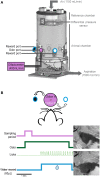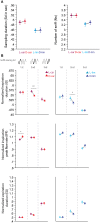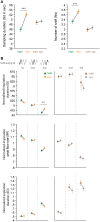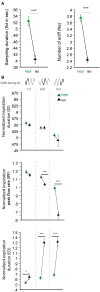Sniff adjustment in an odor discrimination task in the rat: analytical or synthetic strategy?
- PMID: 24834032
- PMCID: PMC4017146
- DOI: 10.3389/fnbeh.2014.00145
Sniff adjustment in an odor discrimination task in the rat: analytical or synthetic strategy?
Abstract
A growing body of evidence suggests that sniffing is not only the mode of delivery for odorant molecules but also contributes to olfactory perception. However, the precise role of sniffing variations remains unknown. The zonation hypothesis suggests that animals use sniffing variations to optimize the deposition of odorant molecules on the most receptive areas of the olfactory epithelium (OE). Sniffing would thus depend on the physicochemical properties of odorants, particularly their sorption. Rojas-Líbano and Kay (2012) tested this hypothesis and showed that rats used different sniff strategies when they had to target a high-sorption (HS) molecule or a low-sorption (LS) molecule in a binary mixture. Which sniffing strategy is used by rats when they are confronted to discrimination between two similarly sorbent odorants remains unanswered. Particularly, is sniffing adjusted independently for each odorant according to its sorption properties (analytical processing), or is sniffing adjusted based on the pairing context (synthetic processing)? We tested these hypotheses on rats performing a two-alternative choice discrimination of odorants with similar sorption properties. We recorded sniffing in a non-invasive manner using whole-body plethysmography during the behavioral task. We found that sniffing variations were not only a matter of odorant sorption properties and that the same odorant was sniffed differently depending on the odor pair in which it was presented. These results suggest that rather than being adjusted analytically, sniffing is instead adjusted synthetically and depends on the pair of odorants presented during the discrimination task. Our results show that sniffing is a specific sensorimotor act that depends on complex synthetic processes.
Keywords: discrimination; olfaction; olfactomotor act; rat; sniffing; sorption properties.
Figures






Similar articles
-
Significance of sniffing pattern during the acquisition of an olfactory discrimination task.Behav Brain Res. 2016 Oct 1;312:341-54. doi: 10.1016/j.bbr.2016.06.039. Epub 2016 Jun 22. Behav Brain Res. 2016. PMID: 27343936
-
Testing the sorption hypothesis in olfaction: a limited role for sniff strength in shaping primary odor representations during behavior.J Neurosci. 2013 Jan 2;33(1):79-92. doi: 10.1523/JNEUROSCI.4101-12.2013. J Neurosci. 2013. PMID: 23283324 Free PMC article.
-
Interplay between sniffing and odorant sorptive properties in the rat.J Neurosci. 2012 Oct 31;32(44):15577-89. doi: 10.1523/JNEUROSCI.1464-12.2012. J Neurosci. 2012. PMID: 23115193 Free PMC article.
-
Anatomical contributions to odorant sampling and representation in rodents: zoning in on sniffing behavior.Chem Senses. 2006 Feb;31(2):131-44. doi: 10.1093/chemse/bjj015. Epub 2005 Dec 8. Chem Senses. 2006. PMID: 16339266 Review.
-
The anatomical logic of smell.Trends Neurosci. 2005 Nov;28(11):620-7. doi: 10.1016/j.tins.2005.09.005. Epub 2005 Sep 21. Trends Neurosci. 2005. PMID: 16182387 Review.
Cited by
-
The deep and slow breathing characterizing rest favors brain respiratory-drive.Sci Rep. 2021 Mar 29;11(1):7044. doi: 10.1038/s41598-021-86525-3. Sci Rep. 2021. PMID: 33782487 Free PMC article.
-
Olfactory memory networks: from emotional learning to social behaviors.Front Behav Neurosci. 2015 Feb 17;9:36. doi: 10.3389/fnbeh.2015.00036. eCollection 2015. Front Behav Neurosci. 2015. PMID: 25741259 Free PMC article. No abstract available.
-
Tests of the sorption and olfactory "fovea" hypotheses in the mouse.J Neurophysiol. 2017 Nov 1;118(5):2770-2788. doi: 10.1152/jn.00455.2017. Epub 2017 Sep 6. J Neurophysiol. 2017. PMID: 28877965 Free PMC article.
-
Beta and gamma oscillatory activities associated with olfactory memory tasks: different rhythms for different functional networks?Front Behav Neurosci. 2014 Jun 23;8:218. doi: 10.3389/fnbeh.2014.00218. eCollection 2014. Front Behav Neurosci. 2014. PMID: 25002840 Free PMC article. Review.
-
Tests of the chromatographic theory of olfaction with highly soluble odors: a combined electro-olfactogram and computational fluid dynamics study in the mouse.Biol Open. 2019 Oct 24;8(10):bio047217. doi: 10.1242/bio.047217. Biol Open. 2019. PMID: 31649069 Free PMC article.
References
LinkOut - more resources
Full Text Sources
Other Literature Sources

